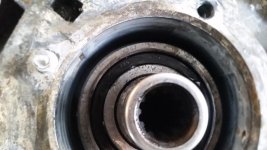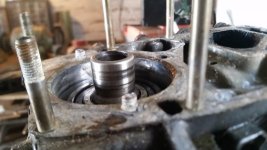FstaRockr Burns
Regular Contributor
I have my powerhead off now cos im replacing the lower seals. The bearing was a little bit loud yet has no play, shd i replace it or just grease it? What at minimum do I need to remove to replace the lower bearing (i dont want a handful of parts falling out)? at the moment its recessed quite deep so not sure how to pull it off?
Also, a friend whose been doing this for yrs said i shd not take the exhaust cover off, but in the manual it says its a very good idea in case theres water in there? what shd i do?

Heres a pic of the bearing - the teflon/plastic side cover partially shows the balls (which mens i can just get some grease in there) - surely this shd be a closed type of bearing? ie does it mean this one is shot or did they come with partially sealed sides?

Was quoted $100 for the mariner part, lo and behold inside is a FAG 6207 C3 bearing.. bit cheaper here: why do marine shops rip u off so bad?!!
http://www.wychbearings.co.uk/6207-2rs-c3_fag.html
Also, a friend whose been doing this for yrs said i shd not take the exhaust cover off, but in the manual it says its a very good idea in case theres water in there? what shd i do?

Heres a pic of the bearing - the teflon/plastic side cover partially shows the balls (which mens i can just get some grease in there) - surely this shd be a closed type of bearing? ie does it mean this one is shot or did they come with partially sealed sides?

Was quoted $100 for the mariner part, lo and behold inside is a FAG 6207 C3 bearing.. bit cheaper here: why do marine shops rip u off so bad?!!
http://www.wychbearings.co.uk/6207-2rs-c3_fag.html
Last edited:


